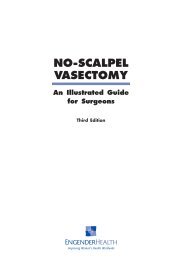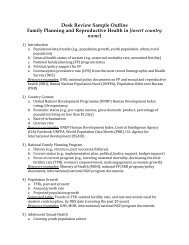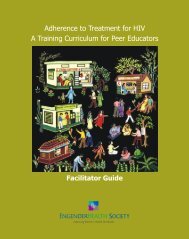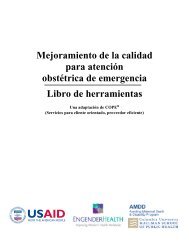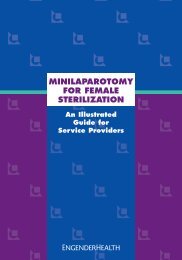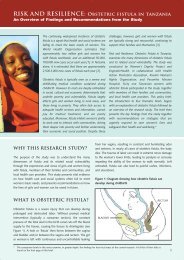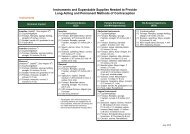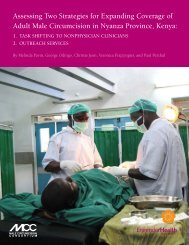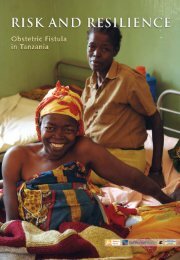COPE® FOR MALE CIRCUMCISION SERVICES - EngenderHealth
COPE® FOR MALE CIRCUMCISION SERVICES - EngenderHealth
COPE® FOR MALE CIRCUMCISION SERVICES - EngenderHealth
You also want an ePaper? Increase the reach of your titles
YUMPU automatically turns print PDFs into web optimized ePapers that Google loves.
spirit of COPE is based on the notion that changes in quality will be most successful and lasting<br />
when they are initiated by staff working together at the facility, using their expertise to<br />
identify problems and to develop recommendations for solving them.<br />
To maximize the benefits and minimize the potential negative consequences, MC services<br />
should follow a comprehensive, quality, client-oriented approach that:<br />
■ Meets clients’ needs while empowering them, by providing information and quality clientprovider<br />
interactions during counseling sessions, to make their own decisions regarding<br />
their health and well-being<br />
■ Helps to maximize the efficiency and effectiveness of services by doing things correctly the<br />
first time someone walks into the facility<br />
■ Increases service utilization by reducing stigma and discrimination and offering a comprehensive<br />
range of quality services<br />
■ Supports comprehensive prevention in which MC is offered alongside HIV counseling and<br />
testing, STI diagnosis and management, and ongoing risk reduction counseling on safer sex<br />
practices, including condom demonstration and promotion.<br />
■ Improves referral networks and links between clinics and communities<br />
Quality of services will be one of the key factors for the success of MC. One critical component<br />
of improving or maintaining quality of services is meeting the needs of all health care staff,<br />
so that they can provide quality client-centered services. Some impediments to the provision<br />
of quality MC services may be beyond the control of site staff, but others may be remedied via<br />
simple and creative measures that greatly enhance the services provided. This COPE toolbook<br />
is designed to assist MC providers and other health care staff in identifying and solving<br />
problems that compromise the quality of adult MC services. While much of what is covered in<br />
this toolbook also applies to neonatal circumcision, this resource is not recommended for quality<br />
improvement of neonatal MC services.<br />
A number of quality improvement approaches—namely self-assessment, peer assessment,<br />
supportive supervision, and accreditation—have proven useful as methodologies for assessing<br />
and improving quality of health services. The WHO’s quality assurance guide (2008) and its<br />
quality assessment toolkit (2009) for male circumcision services encourage staff in a range of<br />
health care settings to use peer assessment and self-assessment as well as supportive supervision<br />
as part of their quality approach and recommend accreditation for facilities seeking<br />
external recognition for their services. COPE ® for Male Circumcision Services, which is based<br />
on a self-assessment approach, complements these WHO quality assurance resources. Both<br />
are based on a similar set of standards of care.<br />
One of the advantages of COPE is that it provides a low-cost, practical approach to engaging<br />
health staff and managers involved in MC service delivery at the local level, irrespective of<br />
the MC service setting (e.g., facility-based services or mobile outreach). It also builds capacity<br />
and develops ownership of continuous quality improvement by guiding MC staff and<br />
managers to focus on problems that they can address themselves. Finally, it empowers them<br />
to proactively and continuously assess and improve the quality of their services over<br />
time. The disadvantages of COPE include that it requires initiative and follow-through in the<br />
service setting, and participants may lack the technical and clinical skills to assess quality<br />
accurately. Based on the advantages and disadvantages of various quality improvement<br />
approaches, countries should decide which one best addresses their situation and needs.<br />
vi <strong>EngenderHealth</strong>



